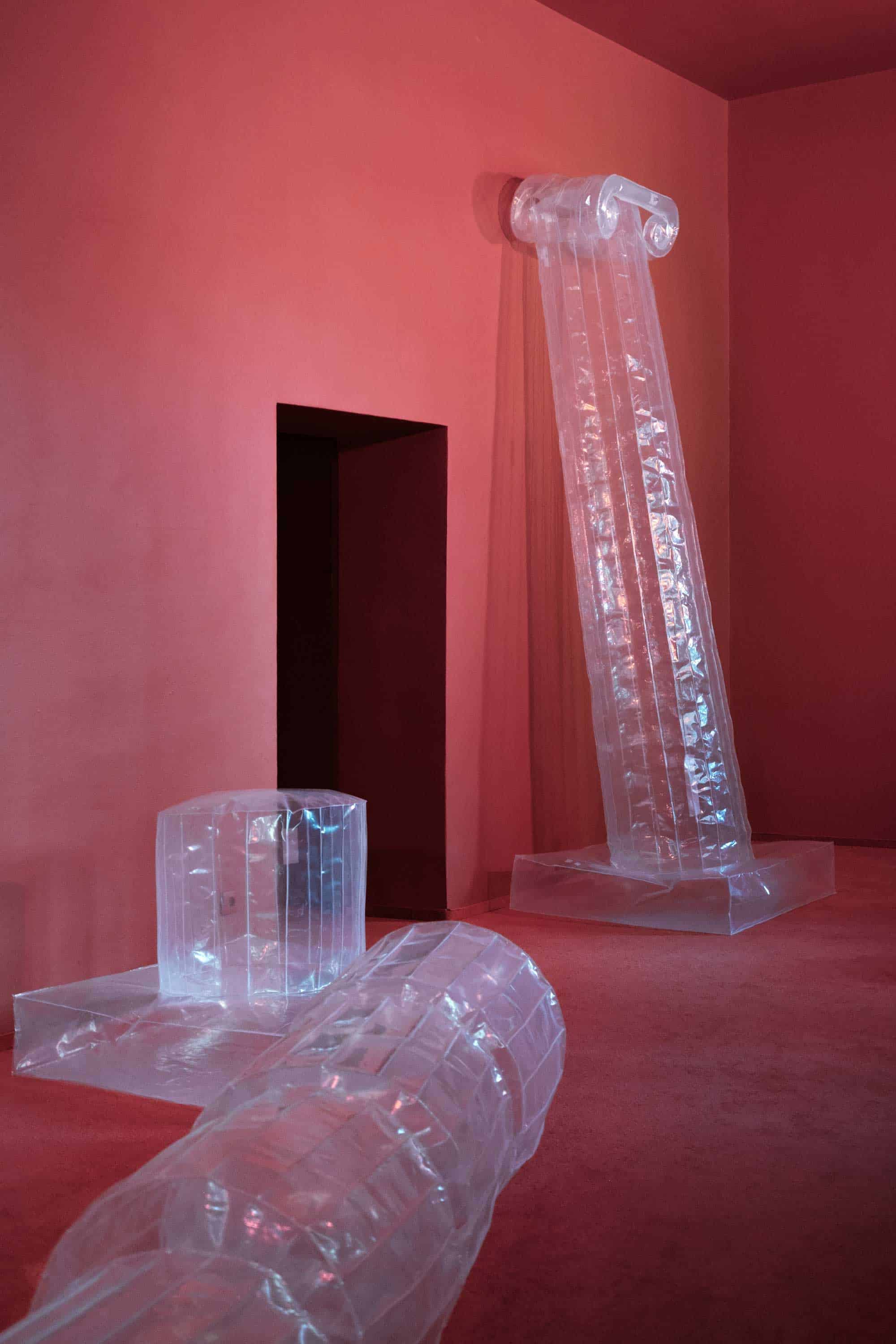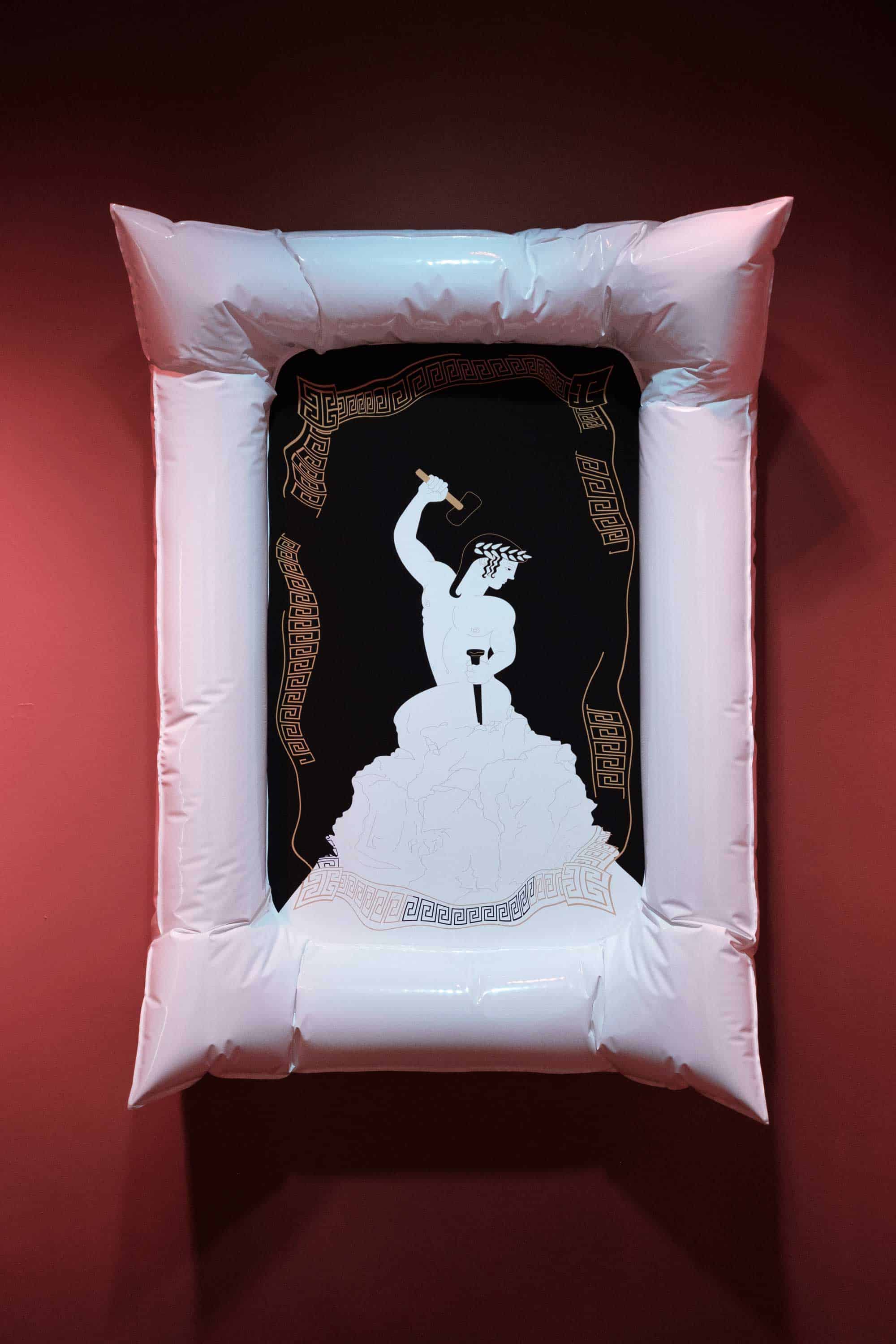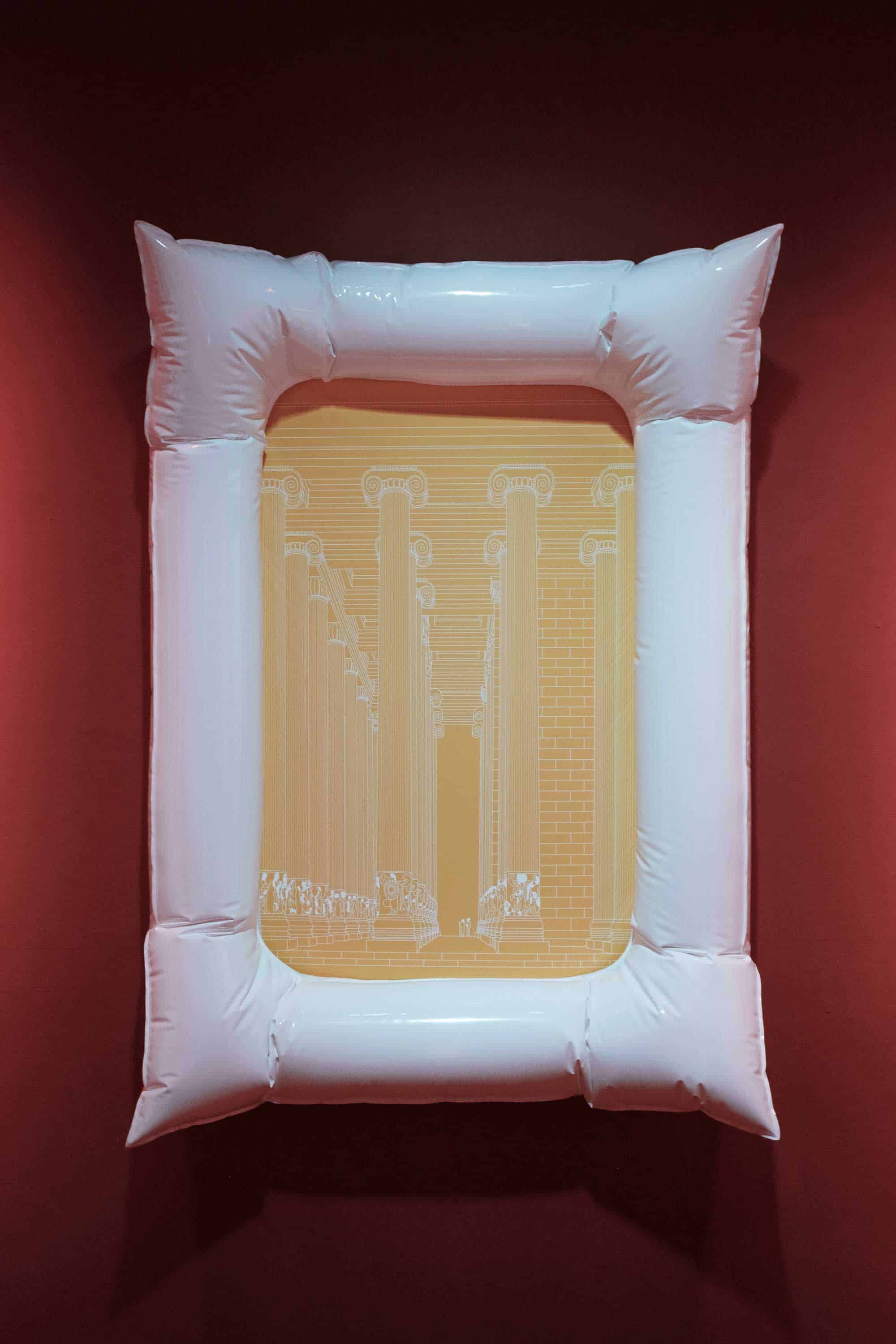In her conversation with Zuzanna Czebatul, Karolina Kliszewska undertakes a critical evaluation of the themes explored in the T-Kollaps exhibition at Gdańsk City Gallery.

Karolina Kliszewska: Antiquity lives! – This declaration seems to virtually burst out of your mouth, as you leave this exhibition with a joyful grimace of sorts. I had initially assumed that I was going to raise awareness of the condition, adaptation and traces of antiquity in contemporary Polish and European culture. However, critic’s intuition compels me to make a cognitive foray in another direction. FORUM GDAŃSK, a shopping mall, has recently opened in close proximity to the Old Town. In brochures, developers claim to have drawn inspiration for the design and name of this modern public venue from the Forum Romanum, the center of political, religious and social life in ancient Rome. The spectacular building is the epitome of modern architecture, catering to our preferred leisure activities combined with consumption. The same mechanism applies to the contemporary state of tourism. Rome, Paris and Athens – these capitals, host some of the most astonishing museums in the world, have all been transformed into global commodities.
Zuzanna Czebatul: Currently we can observe a desire to shape new things with a traditional touch, conveying calm and comfort through familiarity. An extreme example is Frankfurt/Main, where I studied: recently a long debated renovation of Frankfurt’s Old Town was finished. There were two parties, one suggested an accurate reconstruction of the houses destroyed in the WWII. The other was strictly against the historic facades, not only criticizing the Disneyland-ish fakeness behind it, but also the overwriting of history, a softening of the Nazi past with a folkish or even racial intention. The Gdańsk Forum seems to be based on a similar idea: it triggers a sense of sublime, timeless modernity while advertising itself with noble intentions, like being community-driven. Most striking are the little pitched roofs which refer to rural architecture and localism, an effective way to package the oh-so frightening globalization. Architecture which implements the past always constructs identity. That’s perfect for a place containing faceless global companies that need to establish local links to create a path to its consumers.
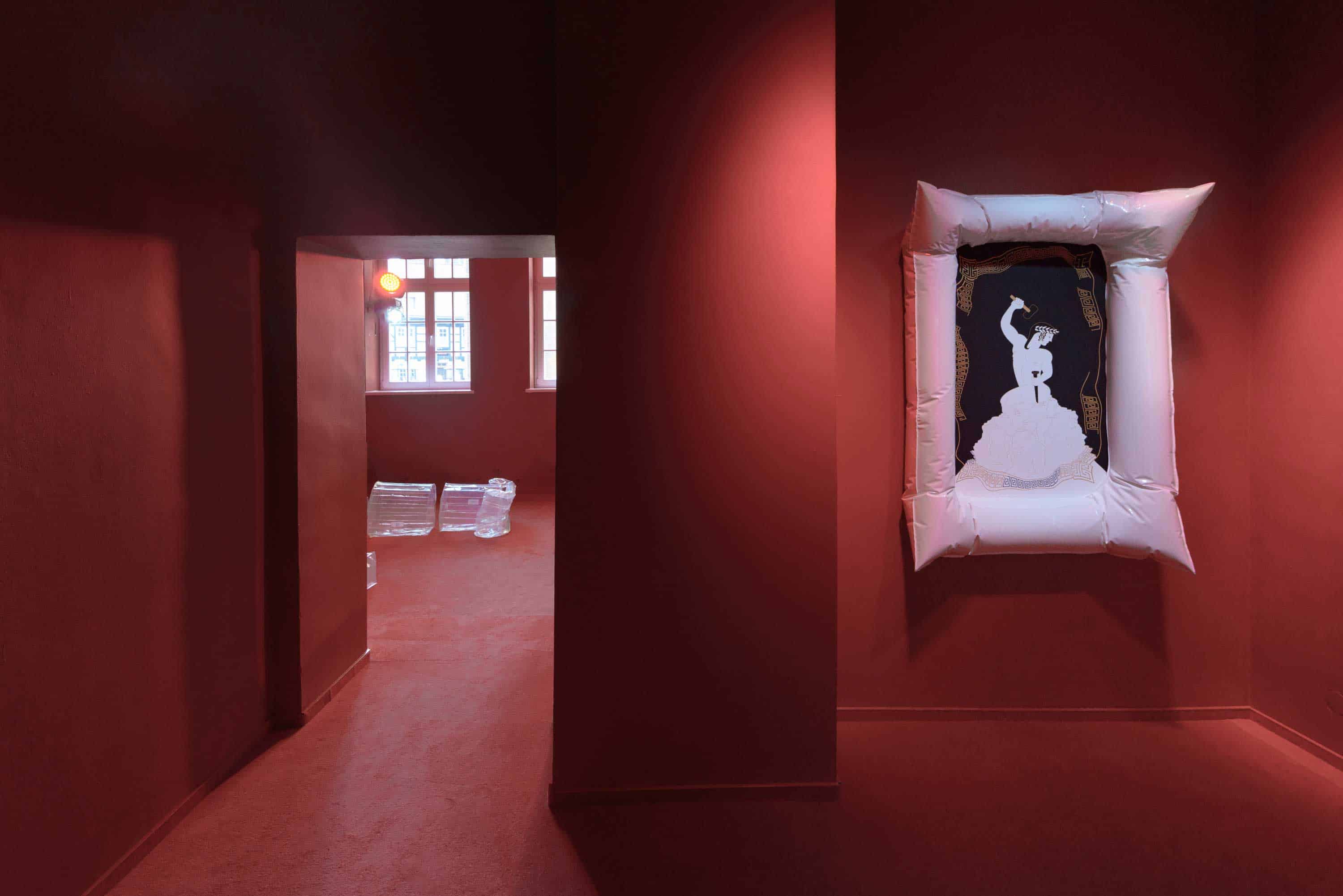
Zuzanna Czebatul, T-Kollaps, exhibition view, Gdańska Galeria Miejska, 2019, photo: Bartosz Górka
KK: Your benevolent and commonplace kitsch aesthetics seems to induce a drastic transposition and deconstruction of history. What is more, this transposition refers to the components of antique architecture typically subject to a picturesque decay as opposed to the modernism or contemporaneity, which are usually consigned to obscurity after a couple of years. In my opinion, the antique order is undermined to some degree by your unprecedented visual and formal approach. Was your intention as an artist to renounce the primordial forms of sculpture and architecture? Or is the installation a formal, material and experimental exercise in a semantic expansion of the notion of sculpture?
ZC: The French Romantic author Chateaubriand once stated: “All men have a secret attraction to ruins. This feeling stems from the fragility of our nature, from a secret conformity between these destroyed monuments and the rapidity of our existence.” This sentimental fascination derives from nostalgia, a state which implies longing for the past grander than one’s own. It is a kitschy notion, even more so today since nothing new will decay nicely while our entire timeline data is saved on big servers. So the ancient societies seem to also teach us something else: we should never take anything for granted. The stuff we produce today will not live as long as the Parthenon and maybe that makes us even more vulnerable and sentimental. Using a throwaway material to mimic an overloaded and seemingly indestructible symbol of stability and order is the way to highlight this ambiguity and to question the durability and value we assign to the objects preserved and manufactured by our society. This includes not only artifacts and thus heritage, but also contemporary art, the production of which is nowadays accelerated to such an extent that it comes close to other easily digestible commodities or the pace of fashion and tech industries.
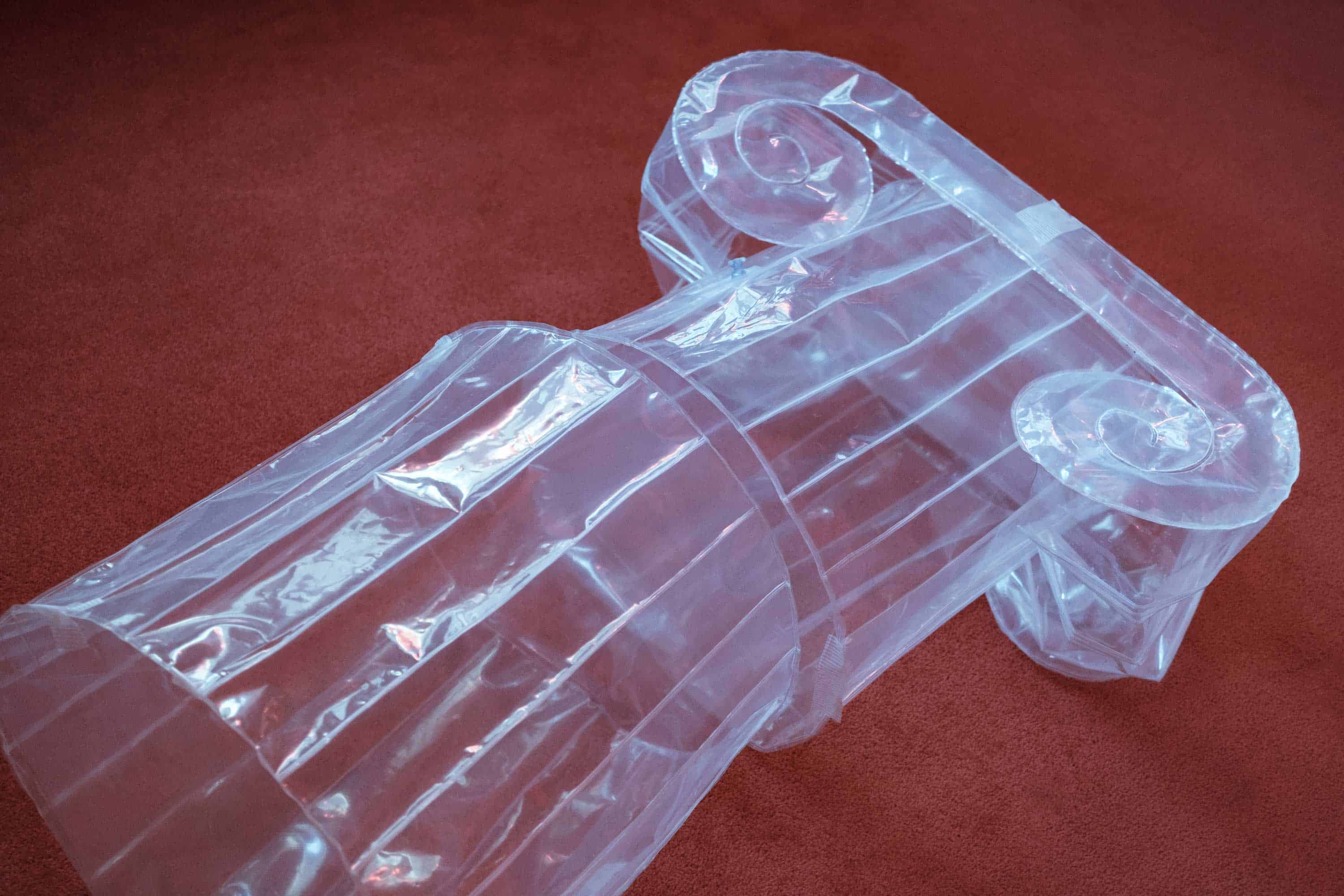
Zuzanna Czebatul, T-Kollaps, exhibition view, Gdańska Galeria Miejska, 2019, photo: Bartosz Górka
KK: I’m glad you have raised this issue. Nowadays, we often face a partial or complete ignorance of the temporal aspect intrinsic to designing and mapping-out the spatial, social, political and cultural shifts. Although the intellectual and economic capital of our culture has always been considered as inexhaustible and safeguarded, it soon might get irretrievably squandered. Should the prospect of this loss be imbibed obsessively by the European culture? What do you think?
ZC: The argumentation of right-wing parties in Europe, including the current Polish government, proclaims that Europe and its history are endangered, that refugees and Islam aim to destroy the Occident and its values. Whereas, these parties are the ones that destabilize the democratic pillars which have built it. It sounds paradoxical but the flaw in democracy is that it can vote itself out. Here, the sentiment turns into rage or fear that lay bare how desperate we are to define ourselves in times of political numbness originating from the unlimited domination of neo-liberal capitalism. The designation of an enemy is a helpful and dangerous tool, and we know how it ended the last time. I believe we have to find new ways of forming an identity, away from past-directed, national or religious identification, towards a common sense of how we want to act as a society with values enabling a future, not destroying it.
KK: T-Kollaps demonstrates an account of disintegration, climate change, as well as the political and socio-cultural transition. In the aftermath of the industrial, then digital revolution, these processes have gained rapid momentum. In today’s age of globalization, their lifespan corresponds roughly to the duration of your exhibit. Who knows? Perhaps a closing of your show will confront us with the collapsed / deflated forms that bear absolutely no resemblance to their original condition? Does T-Kollaps embody your outlook on tradition? Or is the piece rather an expression of our current predicament, an emotionally and intellectually draining collective disappointment?
ZC: There is a lot of ways to interpret the performative aspects of the installation. Of course they are strongly linked to the rapidity of progress we currently witness, but also the slowness we observe in relation to the issues which have become of utmost urgency to solve. Above all, there is the question whether we are too busy to recognize the leaks and flaws.
KK: Your strategy to preserve the present highlights rather those aspects of the current reality that we deem tacky (used material, ubiquitous plastic), ostentatious (scale, lighting, megalomania and technocracy) and fabricated (arrangement and form, eternal reproduction and copying). Are these formal solutions a way to resolve the ideological quandaries plaguing our contemporaneity? Or are they a method for forging a new connection with the world?
ZC: In the best case scenario, the current level of distortion will produce a new forward-thinking definition of what we aspire to be as society. There are different and polar opposite ideas which compete at the moment creating a mess, like a teenager in hormone-raging puberty. But chaos harbor the great potential. Art offers a preview into those potentialities. Doomsday and hope are encouraged to go hand in hand. By distorting, scaling and shifting imagery and materiality, my works often ask questions starting with ‘what if..?’
KK: In 2014, the Eclectic Electric Collective’s art show entitled “Disobedient Objects” showcased the inflated cobblestones used during street protests as weapons or barricades’ structural components. The exhibit demonstrated how political activism drives a wealth of ingenuity and collective activity, which contests the standard definition of art and design. Instead of diminishing the significance of an object, the collective’s piece sneered at powers that be who assemble military forces to keep societies in check. Their ridicule of the government is embodied by armed policemen running amuck, trying to pop the balloons. A different context notwithstanding, wouldn’t you agree that the T-Kollaps exhibit is targeted at a very precise type of audience – group of art viewers – in order to mock their predilection for “sightseeing” or even attempts to interact with works of art by taunting them to marvel at an inflatable amusement park?
ZC: Inflatables are associated with innocence, leisure and entertainment. Besides toys, they are communication tools in advertisement and politics since the 20th century. An analysis of those harmless and fun-looking strategies triggers an understanding of how such objects and their metaphors are instrumentalized until today, where discourse gets dumbed down in favour of populism or propaganda, where effigies of ethnic groups and books are burned again. To be fair, not every viewer might be able to distinguish between an exhibition space and an amusement park. Though it’s not the responsibility of a single institution to communicate this difference, it should always aim to. And if the sensory experience of an art work triggers interest and opens a space for a critical dialogue, then the potential of art is utilized to the same degree as on the other side of the spectrum.

Zuzanna Czebatul, T-Kollaps, exhibition view, Gdańska Galeria Miejska, 2019, photo: Bartosz Górka
KK: Your works / objects aligned perfectly in gallery space transform your art exhibits into all-encompassing site-specific installations fused into this space. T-Kollaps creates a grandiose spatial composition, its formula evokes a powerful sense of deception. The artificiality of an exposition does neither rub us the wrong way nor infuriate, quite the contrary. It delights and thrills us as we absorb its quality pretty much right away. When all is said and done, this reaction should unsettle us the most. By rekindling memories from our astonishing travels, the entirety of an installation establishes an unquestionable diagnosis – our cities’ whole purpose boils down to them being first and foremost the objects to be gazed at / appraised. I used to scour for beauty amidst the artificiality of industrial urban landscapes, business parks and shopping centres. The aesthetic pleasure we experience as we stroll around the contemporary variations of Forum Romanum (i.e. Forum Gdańsk), the historic Acropolis or most notably the T-Kollaps exhibit gives us an impression of drawing nearer the very foundations and archetypes of our culture, while demonstrating the fact that we are actually standing on the vast graveyard of ideas.
ZC: That’s a great way to put it ☺ Exhibition spaces are temporary stages for objects, ideas and scenarios and, like in T-Kollaps, I often use all of that space. I like to dissolve the boundaries within and therefore extend both the work and the space. The environment around a piece becomes the part of it. The location, city or country of the exhibition are often included in the concept. So the architecture of the space becomes thereby one of the fundamental pillars of the installation it hosts. It is not a coincidence that T-Kollaps found its stage in Poland.
By Karolina Kliszewska
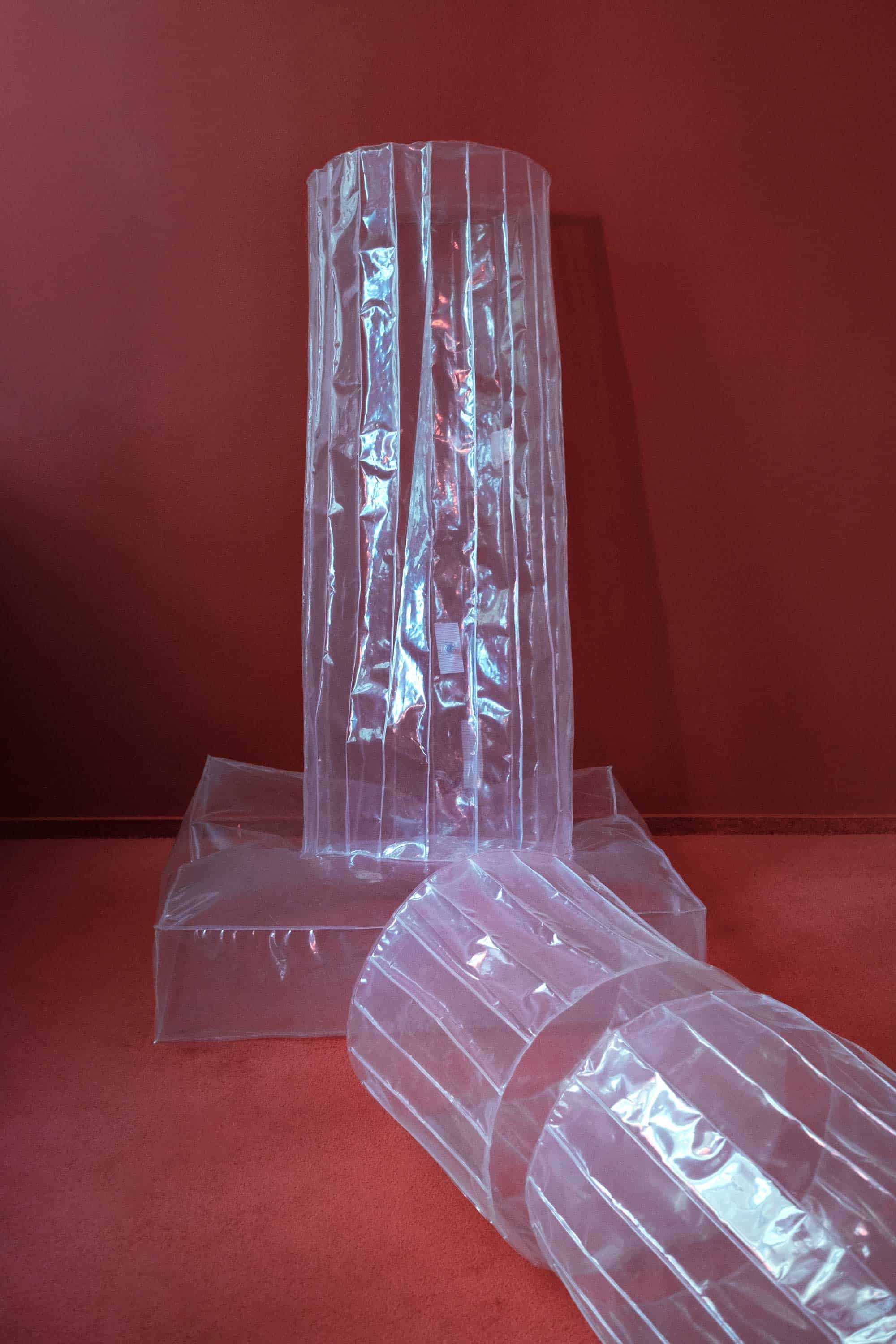
Zuzanna Czebatul, T-Kollaps, exhibition view, Gdańska Galeria Miejska, 2019, photo: Bartosz Górka









